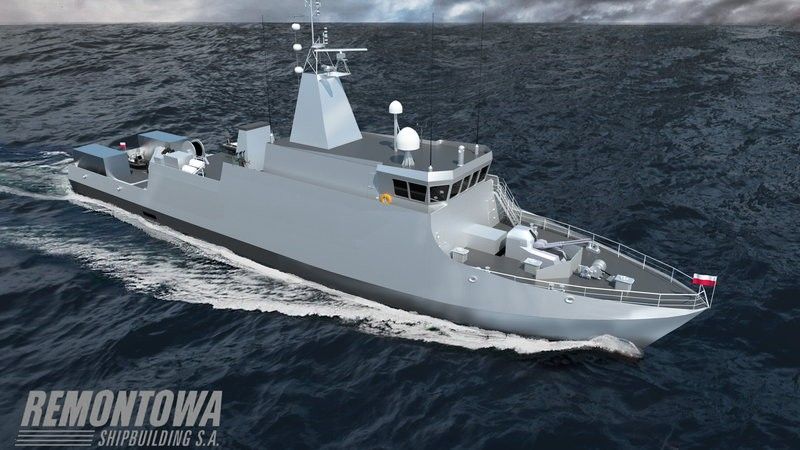Combat Management System Of The Kormoran II Mine-hunter Initialized – The Vessel Will Be Launched With No Delay

The Research and Development Center of the Centrum Techniki Morskiej S.A. (Center for Maritime Technology) in Gdynia has launched the combat management system dedicated for use with the „Modern Kormoran II Minehunter” yesterday. During the event, the ordering party (Polish Ministry of Defence), as well as the Contractor (the task consortium) have both confirmed that the programme related to construction of that vessel is being realized without any delays, and no significant threats to its realization are present.
The system has been initiated during the opening ceremony of the “Laboratory of Naval Systems Integration” which is currently dedicated to be used in the process of development regarding the mine-hunters. The ceremony was attended by the representatives of the Ministry of Defence (Division General Mirosław Różański), Armament Inspectorate, PGZ (Polska Grupa Zbrojeniowa – Polish Armament Group), Shipbuilding Repair Shipyard, Polish Navy Shipyard, Gdynia authorities, the Naval Academy, Gdansk University of Technology and finally – of the Navy.
During the ceremony, the Polish Ministry of Defence played a role of the co-host, who opened the laboratory, by initiating the combat management system.
Laboratory – what for?
“Laboratory of Naval Systems Integration” was created as a part of the development works realized for the Polish Ministry of Defence, starting from 23rd September 2013. Ultimate objective to be realized by the facility is to hand-off the complete prototype of the Kormoran II mine-hunter, and this process is to be realized completely in Poland.
The works are being realized by a consortium consisting of the following companies: Shipbuilding Repair Shipyard (leader), Polish Navy’s Shipyard (Stocznia Marynarki Wojennej S.A.) and R&D Centre of the Centre for Maritime Technology (Ośrodek Badawczo-Rozwojowy Centrum Techniki Morskiej S.A. - OBR CTM). This consortium has developed a detailed task distribution, according to which the OBR CTM is responsible for development, inter alia, of the mine detection sonar system, command and weapons control system and for integration of these systems with the vessel. Maritime battlefield management system, also known as SCOT-M. The latter suite was developed by OBR CTM S.A., and it is the basis for all of the works specified above.
The newly opened laboratory is also to become a technological base for the Polish naval command systems for the newly constructed vessels, within the operational programme, the aim of which is to neutralize the maritime threats. Not only may the solutions realized here be used by the mine-hunters, but they also may be utilized in case of the coastal defence vessels or patrol vessels that have mine-hunting capabilities.
Additionally, the system may also be utilized to train the crews and to check the newly developed solutions that may be implemented in case of the new mine-hunter, long time before they are installed on board of the ship. The lab is also a perfect place to test the new software, without the need of involving the ships that may be involved in the sea operations at the time when the test procedures are being carried out.
How does it all work?
The current layout of the laboratory replicates the Kormoran II mine-hunter combat information centre with a high degree of fidelity. Some of the consoles are the same as those used on-board of the ship, some of them are simulated by computers with a proper set of software. We should recall that according to the layout, the command centre of the Kormoran II mine-hunter can make work of even seventeen operators possible.
The system supports the combat activities of the crew within the scope of effective application of all the sensors and effectors utilized on the ship. Secondly the devices help in the process of mission planning, especially when it comes to the tasks of search, classification, identification and neutralization of the mines. Thirdly, the system also supports the decision making, monitors the realization of the objectives, reporting and training and simulation procedures.
The standard operational scenario involves the initial detection, which is realized with the use of an autonomous underwater vehicle, such as Hugin 1000, which is lowered from the stern section of the vessel. Mine-like objects, which are detected by a side-looking sonar of the drone, are later searched for by the keel sonar or by a remotely controlled vehicle, equipped with a SPVDS sonar.
After the classification stage is completed, the object is being identified, e.g. with a remotely controlled disposable anti-mine vehicle, or multiple-use vehicles. After the identification is successfully carried out, mine destruction process starts, however, the method which is to be used here is to be selected by the ship’s commander.
What’s next for the Kormoran II?
Handing-off the laboratory working on integration of the maritime systems, utilizing the SCOT-M system, constitutes yet another stage within the Kormoran II programme. Hull of that vessel has been already completed and it is now being equipped by the Shipbuilding Repair Shipyard based in Gdansk. Ship launch is planned to happen in between July and August this year.
Considering the above, the Ordering Party (the Polish MoD), as well as the contractor (the consortium) both have confirmed that the Kormoran II programme is not delayed and that the vessel would be handed-off according to the initial plan, in October next year.

WIDEO: Defence24 Days 2025: Premier Defence & Security Conference in CEE